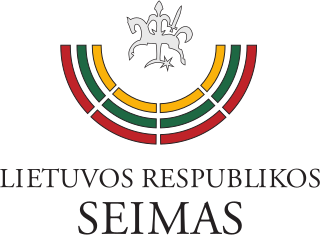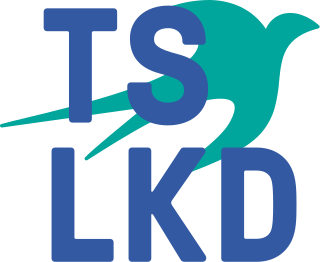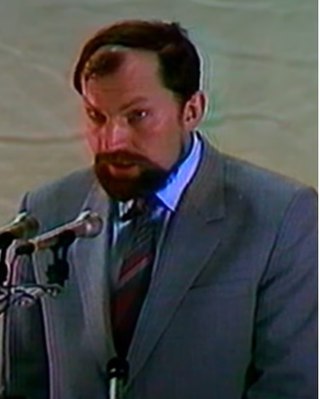Related Research Articles

Politics of Lithuania takes place in a framework of a unitary semi-presidential representative democratic republic, whereby the president of Lithuania is the head of state and the prime minister of Lithuania is the head of government, and of a multi-party system.

The Seimas of the Republic of Lithuania, or simply the Seimas, is the unicameral legislative body of the Republic of Lithuania. The Seimas constitutes the legislative branch of government in Lithuania, enacting laws and amendments to the Constitution, passing the budget, confirming the Prime Minister and the Government and controlling their activities.

The Homeland Union – Lithuanian Christian Democrats, also colloquially known as the Conservatives, is a centre-right political party in Lithuania. It has 18,000 members and 28 of 141 seats in the Seimas. Its current leader is Gabrielius Landsbergis, who replaced Andrius Kubilius in 2015. It is a member of the European People's Party (EPP) and the International Democracy Union (IDU).

Albertas Šimėnas was Prime Minister of Lithuania for 3 days, from 10 to 13 January 1991. He disappeared during the January Events and was replaced by Gediminas Vagnorius.

The Government of Lithuania, officially the Government of the Republic of Lithuania, is the cabinet of Lithuania, exercising executive power in the country. Among other responsibilities, it executes laws and resolutions of the parliament, the Seimas, and the decrees of the President, manages state property and, together with the president, executes the foreign policy of the country. The Government also has the right of legislative initiative, puts together the state budget and presents it to the Seimas for approval.

Presidential elections were held in Lithuania on 22 December 2002 and 5 January 2003. Incumbent President Valdas Adamkus ran for reelection alongside sixteen other candidates, the largest field of presidential candidates in the country's history. Though Adamkus held a large lead over his closest opponent, Rolandas Paksas of the Liberal Democratic Party (LDP), in the first round of the election, Paksas defeated Adamkus in the second round with 54.71% of the vote.

Parliamentary elections were held in Lithuania in two stages on 20 October and 10 November 1996. All 141 seats in the Seimas were up for election; 70 based on proportional party lists and 71 in single member constituencies. Where no candidate gained more than 50% of the vote on 20 October, a run-off was held on 10 November.

Presidential elections were held in Lithuania in December 1997 and January 1998. Artūras Paulauskas finished first in the first round on 21 December 1997 with a significant margin, with Valdas Adamkus finishing second, but neither received a majority of the vote. Adamkus defeated Paulauskas in the runoff, held on 4 January 1998. With a vote difference of 0.74%, it is the closest result in the history of presidential elections in Lithuania since 1993.

The Supreme Council – Restoration Seimas of the Republic of Lithuania, was the supreme governing body, elected in 1990. Its first meeting was held on 10 March 1990, and its last on 11 November 1992.
The Sixth Seimas of Lithuania was the first parliament (Seimas) elected in Lithuania after it restored independence on 11 March 1990. Elections took place on 25 October 1992, with the second round on 15 November. In a surprisingly decisive outcome, the elections were won by Democratic Labour Party of Lithuania (LDDP), with 73 seats. The result reflected widespread dissatisfaction with the economic situation and the policies of the ruling Sąjūdis political movement in the preceding Supreme Council of Lithuania.

The Second Brazauskas Cabinet was the 13th cabinet of Lithuania since 1990. It consisted of the Prime Minister and 13 government ministers.

The First Kubilius Cabinet was the 10th cabinet of Lithuania since 1990. It consisted of the Prime Minister and 14 government ministers.

The First Paksas Cabinet was the 9th cabinet of Lithuania since 1990. It consisted of the Prime Minister and 14 government ministers.

The Second Vagnorius Cabinet was the 8th cabinet of Lithuania since 1990. It consisted of the Prime Minister and 17 government ministers.
Stankevičius Cabinet was the 7th cabinet of Lithuania since 1990. It consisted of the Prime Minister and 19 government ministers.
Lubys Cabinet was the 5th cabinet of Lithuania since 1990. It consisted of the Prime Minister and 17 government ministers.

Abišala Cabinet was the 4th cabinet of Lithuania since 1990. It consisted of the Prime Minister and 18 government ministers.
Šimėnas Cabinet was the 2nd cabinet of Lithuania since the declaration of independence in 1990. It consisted of the Prime Minister and 17 government ministers.
Prunskienė Cabinet was the 1st cabinet of Lithuania since the declaration of independence in 1990. It consisted of the Prime Minister and 17 government ministers.

Saulius Skvernelis is a Lithuanian politician who served as prime minister of Lithuania between 2016 and 2020. He had previously served as police commissioner, and was Minister of the Interior from 2014 to 2016. Though he was an independent politician, he was backed by the Lithuanian Farmers and Greens Union and was a member of its parliamentary group until 2022, as a result of which he became the first head of government in European history primarily backed by a green party.
References
- 1 2 "Ankstesnės Vyriausybės. Po 1990 metų". Government of the Republic of Lithuania.
- 1 2 "Kaip 1992 m. įtvirtinta šiandieninė rinkimų sistema: Politikų ginčai ir rinkimų datą lėmusi moneta". 8 November 2020.
- ↑ "Vienuolika metų - dvylika premjerų". Delfi.lt. Retrieved 23 May 2016.